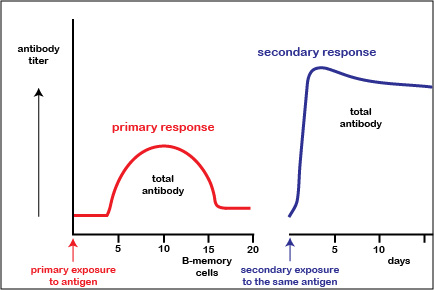Fig. 2: Anamnestic Response
After the primary exposure to an antigen, there is an inductive period of generally several days to a week when no measurable antibodies are detected in the serum. This is the period when the antigen is being exposed to immunocompetent cells, being processed by APCs, clonal selection and clonal expansion are taking place, and B-lymphocytes are differentiating into plasma cells and B-memory cells. Because of the memory cells, however, a second exposure to the same antigen results in more antibodies being made faster for a longer period of time, as shown in the secondary response.
Professor of Microbiology, The Community College of Baltimore County, Catonsville Campus
This work is licensed under a Creative Commons Attribution 4.0 International License.
Based on a work at https://cwoer.ccbcmd.edu/science/microbiology/index_gos.html.
Last updated: August, 2019
Please send comments and inquiries to Dr.
Gary Kaiser

